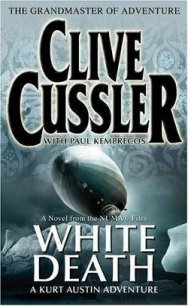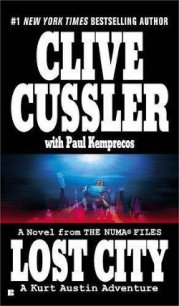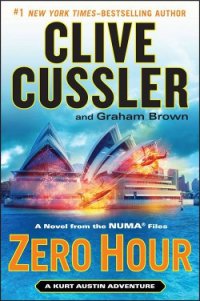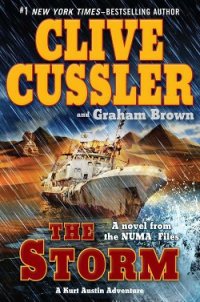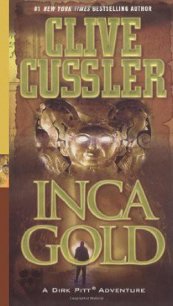The Navigator - Cussler Clive (читаем книги онлайн бесплатно полностью .TXT) 📗
Austin pondered his next move. Like most men who follow the sea, he had the deepest respect for watery graves. He could surface and report the find to the authorities. But the heavy hand of police divers could destroy whatever secrets the wreck might have yielded.
He wrapped his arms around the helmet and carefully wrestled it free. The skull dropped out of the bottom and landed upright. Austin took comfort in the fact that the dead diver was still grinning.
He avoided the baleful eye sockets and took a lift bag from a pouch. He tied the lines from the bag to the helmet’s neck and inflated the lifter with air from his tank. He inflated his buoyancy compensator, grabbed the helmet, and slowly ascended to the surface.
Zavala had watched the primitive salvage effort on the ROV’s monitor. He saw Austin’s head pop up at the surface and threw him a line. Austin tied the line to the helmet so it wouldn’t sink. He handed Zavala his air tank, weight belt, and fins, and then he climbed a ladder into the boat.
They bent their backs to the line and hauled the helmet onto the deck.
Austin pulled his hood off and knelt next to the helmet. “This is an old-timer,” he said. “Probably been down there for years.”
Zavala examined the air hose fitting and the ear plates and face-plates. He ran his fingers over the metal dome. “The workmanship is incredible. It’s made of brass and copper.” He tried to lift the helmet and the attached breastplate. “This baby must weigh more than fifty pounds. The guy who wore this thing must have been as tough as nails.”
“Not tough enough,” Austin said.
“I suspected that was the case,” Zavala said with a glance over the side. “I wonder who he was.”
Austin scraped growth away to reveal an oval piece of metal, engraved with the helmet’s manufacturer, that was riveted to the front of the breastplate. The engraving said that the helmet had been made by the MORSE DIVING EQUIPMENT COMPANY, of Boston. Underneath the manufacturer’s name was a serial number.
“Maybe this will tell us.”
He used a cell phone to call the maritime history division at NUMA. He identified himself to a researcher, who said her name was Jennifer, and gave her the information from the manufacturer’s plate. Jennifer asked for the numbers on the brail straps as well, and said she would run a search and call him back.
Zavala had returned to the ROV control and brought the vehicle back to the surface. He hoisted the compact vehicle out of the water, and Austin coiled the umbilical and laid it neatly on deck, which was when he noticed his stuff bag. He opened the bag and pulled out the tablet. It had been greenish gray under water, but it turned to more of a brown color as it dried. Several intersecting straight lines were incised about a half inch deep on one side. He handed it to Zavala.
“I found this near the helmet. I thought the lines were natural strata variations, but now I’m not so sure.”
Zavala held the tablet at different angles to test the light on the surface. “These lines are too regular and deep to be natural,” he said. “The parallel sides are perfectly even. Definitely man-made. How’s your Phoenician?”
“Pretty rusty,” Austin said. He retrieved the tablet and slipped it into the bag.
They reran the pictures taken by the ROV on its initial pass over the wreck and came up with a new estimate for the length of the ship. After his dive, Austin put it more at two hundred feet.
“One thing’s sure,” Zavala said. “This was no rowboat.”
Austin’s cell phone jingled.
“Looks like you snagged yourself a real prize,” said Jennifer, the NUMA researcher. “You’ve got an authentic twelve-bolt, four-light navy MK diving helmet. Morse was a Boston brassware company that started fiddling around with helmet designs during the Civil War.”
“This looks much newer,” Austin said.
“It is. Your helmet was made in 1944. The MK design has been around since the turn of the century. They improved it through the years. It was a real workhorse for the navy, used for all submarine recovery work during World War Two.”
“Does that mean it was last used during the war?”
“Not necessarily. Someone could have found it at a surplus warehouse or store. If it’s in good shape, it could bring serious money on the collectors’ market.”
“Too bad we don’t know who the owner is,” Austin said.
“I can’t tell you who the diver is, but I tapped into naval records and found out who used it during the war. Navy diver named Chester Hutchins. Navy records say he bought the helmet as surplus after the war. Hometown listed as Havre de Grace, Maryland.”
Austin was familiar with the waterfront town near the mouth of the Susquehanna River. “I know the place. Thanks. Maybe his relatives still live there.”
“At least one does. A Mrs. Chester Hutchins. Got a pen handy?”
Austin found a ballpoint in a box of spare parts and jotted the number down on the margin of the chart. He thanked Jennifer and relayed the information to Zavala.
“Sounds like a solid lead,” he said.
“About as solid as they get,” Austin said. He dialed the number. A woman answered the phone. Austin hesitated. He didn’t want to give anyone a heart attack. But there was no gentle way to break the news.
He asked if she were related to Chester Hutchins.
“I am. I mean, I was. He’s been dead for many years. Who is this, please?”
“My name is Kurt Austin, with the National Underwater and Marine Agency. A friend and I were diving on a wreck in the Chesapeake today and we found a diving helmet. We traced it to your husband.”
“Dear God,” she said. “After all this time.”
“Would you like us to bring you the helmet, Mrs. Hutchins?”
“Please, yes. I’ll give you my address.”
They spoke a few more minutes before Austin hung up.
Zavala had been listening to the conversation. “Well?” he said.
Austin crooked his forefinger and thumb.
“Bingo,” he said with a grin.
Chapter 37
CARINA FELT AS IF she were walking on clouds.
The lunch with two exhibition organizers in the Metropolitan Museum of Art garden cafe had gone far better than she had expected. Things were going her way. Finally.
The organizers had enthusiastically embraced her suggestion that the well-publicized theft of the Navigator would bring people into the museum. They could barely contain their excitement as she traced her long search for the statue, described the attempted theft and the successful one.
The organizers had tossed ideas back and forth like table tennis players and jotted notes down in their electronic organizers.
The Navigator would have its own room. It would be an exhibition within an exhibition, filled with giant National Geographic photographs of the statue being excavated in Syria. Photos of the Iraqi museum. The Egyptian Pyramids. The containership. The Smithsonian. All pieces of the puzzle. The centerpiece would be an empty stage, reserved for the statue, adding an air of mystery.
The exhibition’s theme was a natural: Missing.
The show would be the supreme achievement in museum parlance. A blockbuster.
As Carina took the elevator down from the roof cafe she smiled inwardly. Americans. They may have their problems competing in a global economy, but they hadn’t lost their ability to sell air.
The thought of Americans reminded her to call Austin.
She was tempted to explore some of the museum’s impressive exhibitions, but a glance at her watch told her that the luncheon meeting had gone longer than expected.
She walked briskly through the Great Hall and out the main entrance. She stood between the tall columns at the top of the wide stairway that spilled down to Fifth Avenue and dug her cell phone out of her purse. She scrolled down but stopped short, as she remembered Austin throwing his phone into the Turkish sea.
